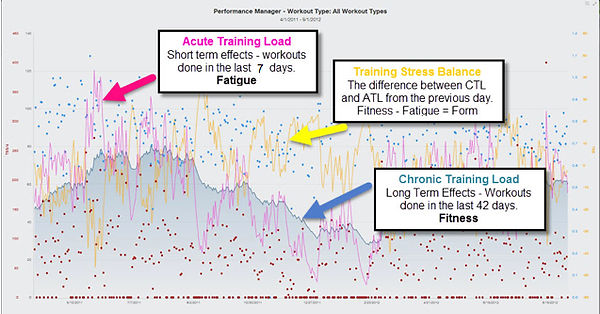


In this Episode
-
Training Peaks series: Performance Management Chart overview
-
The performance management chart is a tool on training peaks that manages all the data that you get from your training device to monitor and track training load.
-
A lot of people do not get much out of all the training data that is collected by their expensive training devices.
-
TSS: Training Stress Score: This is essentially how hard the training session was. This is calculated from a combination of how long and how intense the training session was.
-
ATL: Acute Training Load - Fatigue: This is the short term effect of your training over the last 7 days.
-
CTL: Chronic training load - Fitness: This is the long term effects of your training over the last 42 days of training. Over time the aim is to get this blue line to track upwards towards our key goal
-
TSB: Training Stress Balance - Form: The difference between CTL and ATL from the previous day. On race day we want to be standing on the start line with our fitness as high as possible and our yellow line as high as possible indicating that you are fit and fresh.
-
Over time you start to build up a picture around you, your training and how you hand different training load.
-
-
Sprint Interval Training
-
Sprint interval training has many benefits for endurance athletes.
-
What is power? Power is all about how much work can be performed in a certain amount of time. The formula for this is Force x Velocity.
-
On a bike this would be how hard you push on the pedal's via gearing and how fast you spin the pedals.
-
When working on improving our power output we can manipulate each of these variables individually or both together which is where sprint interval training comes into play.
-
The idea behind these sessions is not developing your lactate threshold of VO2 max they are around neuromuscular power development. They are all out efforts with long recovery periods between each.
-
You can work on peak or sustained power depending on what you need to target for your goal race. A range of different power ranges is a good bet for endurance athletes to cover your basis.
-
Why would do sprint interval training? Things include bridging gaps, sprinting for the finish, punchy climbs, create faster leg turn over, improving force production, improvements in movement efficiency and muscle fiber recruitment all of which result in an improved performance in the real world.
-
Make sure you have a good base fitness before starting and all of your gear is up to scratch as this type of training places a lot of stress on your gear
-
-
Fasted training
-
The concept of fasted training is to challenge your body to make its own energy rather than just relying on the food your are eating for fuel.
-
There are lots of different approaches you can take towards this type of training depending on your training history, experience with this type of training and goals.
-
It is highly recommended that you do not your key interval session fasted as this can negatively affect the training outcomes.
-
Training the gut before a key race is key.
-
Drip feeding throughout the race is a great approach if you suffer with stomach issues as it helps maintain gut blood flow which helps digestion and absorption.
-
If you are doing a lot of fasted training then that can be an issue when racing as your stomach is not use to consume food around exercising hard.
-
Listen below on Sound Cloud
Or
Listen on YouTube
Below
Get a FREE copy of the extended Performance Temple ebook series when you submit a VOICE message below.

Do you want a question answered on the podcast?
Send in a voice message below.
Voice messages will be answered with a priority over written messages.
Simply hit record below
Tell me your name
Where you are from
Then ask your question
Hit stop
Enter your name and email
Send it through
Show Notes
- Training Peaks: Performance Management Chart example













.png)
.png)
.png)
.png)
.png)